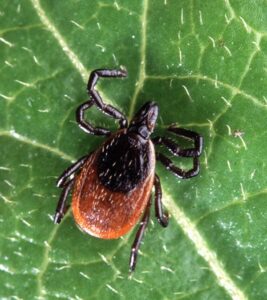-
Adopt
-
Veterinary Care
Services
Client Information
- What to Expect – Angell Boston
- Client Rights and Responsibilities
- Payments / Financial Assistance
- Pharmacy
- Client Policies
- Our Doctors
- Grief Support / Counseling
- Directions and Parking
- Helpful “How-to” Pet Care
Online Payments
Emergency: Boston
Emergency: Waltham
Poison Control Hotline
-
Programs & Resources
- Careers
-
Donate Now
 Susan O’Bell, DVM, MPH, DACVIM (Internal Medicine)
Susan O’Bell, DVM, MPH, DACVIM (Internal Medicine)
General Medicine, Angell Animal Medical Center
angell.org/generalmedicine
generalmedicine@angell.org
617-522-7282
No matter the weather here in New England, most of us enjoy side-by-side outings with our canine companions. Ticks and other external parasites are a pesky, year-round problem that warrant some consideration before heading outdoors. My clients have to hear my stories over and over of the tick I pulled off my dog’s nose during a snowy January evening, or the tick attached to my mother on a recent balmy December afternoon! Ticks are a way of life around here, but hopefully by raising tick prevention awareness we can combat the epidemic of tick borne diseases in both humans and dogs alike. Please review these questions and answers regarding tick exposure, and as always, please reach out to your veterinarian with any additional questions.
 Which ticks are the biggest threat to humans and dogs in our area?
Which ticks are the biggest threat to humans and dogs in our area?
Deer ticks are by far the biggest concern, both because of the diseases they may carry, but also because of their small size, making it more likely for them to go unnoticed and able to attach and transmit diseases. Unfortunately Lone Star ticks are also making an aggressive move into New England, and at the very least have known pockets in Maine and parts of Cape Cod, and likely elsewhere in Massachusetts and parts of New England. These ticks are known for the ability to seek out hosts in a more aggressive fashion, their nastier bites, and their potential transmission of several potentially harmful diseases other than Lyme. We also see American dog ticks with great frequency.
Which diseases are transmitted by deer ticks (“black legged ticks”)?
Lyme disease is by far the most well-known disease transmitted by deer ticks. Perhaps 50-70% of deer ticks in the area carry Lyme disease causing bacteria, so the odds are not in our favor if a tick is able to attach and feed on a human (or dog) for long enough. Deer ticks also have the potential to transmit Anasplasmosis, Powassan virus (rare but getting some recent media attention), babesiosis, and others. Dog ticks are capable of transmitting Rocky Mountain Spotted Fever and tularemia, both rarer but potentially very serious tick borne illness affecting humans and dogs.
What is the best way for PEOPLE to avoid tick bites?
- Stick to well cleared paths, and especially avoid the shrubby, mid height grasses and other plants along borders of paths and between landscapes.
- Wear Permethrin-treated clothing, as it also appears to be a safe and effective way to kill ticks.
- Perform frequent tick checks. Ticks crawl for some time before attaching so there is a window of time when they can be removed before they could transmit disease. Have a friend help you if possible, or use two mirrors, as they often head “North” and could be along your back, back of your neck, behind your ears, and along your hairline. Check for new “freckles.” Until you have seen a deer tick nymph (this is the smallest form of the ticks, more prevalent in spring/early summer), it is hard to appreciate just how tiny they are.
- Place clothing in a hot dryer for 30 minutes to kill any ticks that may remain on clothing.
- Take a shower before bed.
- Wear light/white colored long sleeves, long pants, and tall socks to help spot ticks more easily.
What is the best way for DOGS to avoid tick bites?
- Do your best to keep dogs in well cleared areas as well.
- Be in the habit of using one or more veterinarian approved/recommended tick prevention option. There are MANY options and applications (topical spot-on products, collars, newer oral chewable tablets). Have a discussion with your veterinarian and their support staff to help determine your dog’s risk of tick exposure and to factor any concurrent health issues or allergies. Consider how often your pet swims or gets bathed as although many products are water resistant, they may lose effectiveness with repeated water exposure. Your veterinarian can help you select the safest and most effective products and determine the best dosing interval for products. I recommend using these products year round. Ticks will be out to feed (looking for a warm blooded animal!) on any day that is above freezing.
- Also try to perform tick checks on dogs as they similarly will often be on the outmost fur before settling in on the skin to feed. They also climb to “higher,” warmer spots and I often find ticks around the head, neck, backs of ears, and groins or armpit regions of dogs. Using a “furminator” type brush may help facilitate tick removal before they have attached.
What is the best way to remove a tick?
The best way is to remove it AS QUICKLY AS POSSIBLE – ideally before it has attached or as soon after it has attached as possible. In general you want to grasp the tick as close to the site of attachment with tweezers and pull straight back. If the tick has been attached for any period of time, and if you are not familiar with tick removal, you likely will need to use more force/steady pressure than you might have guessed.
How can I tell what kind of tick I have found?
You may be able to use an internet image search to help identify a tick, or you can save the tick and show it to your physician or veterinarian. Engorged ticks (ticks that are enlarged due to being attached and having a blood meal) are often difficult to identify.
Is there a way to know if the tick I found was carrying any potentially harmful diseases?
If a tick was not attached there is no risk of disease transmission (unlike a mosquito bite which could feed and does not subsequently remain attached). Make a note of the day you found an attached tick as this information could be useful to your veterinarian or physician should illness ensue. Tick identification services are available, however please consider the following guidelines outlined by the Massachusetts Department of Public Health before using these services:
- Tests performed on the ticks are not perfect and they do not test for all infections ticks may be carrying. Therefore, even with a negative result, people should still monitor themselves for the appearance of rash, fever or other unusual symptoms and immediately seek the advice of a health care provider should any symptoms occur.
- If someone has been infected by a tick bite, symptoms may begin to occur even before the results of tick testing are available. People should not wait for tick testing results before seeking medical advice should any symptoms develop.
- A positive test on a tick is not an automatic indication that treatment is needed. A positive test indicates that the tick was infected, but not that the tick was successful in spreading the infection to the person bitten. The longer a tick is attached to you, the greater the chance that it will spread infection. Discuss any positive test results with your health care provider.
What symptoms of illness should I be looking for if I removed an attached tick (human exposure)?
Whenever someone removes an attached tick from his/her body, he/she should watch for the appearance of any type of rash, and/or fever or flu-like symptoms (muscle aches, lethargy). Immediately seek the advice of a health care provider should any symptoms occur, especially if the tick was attached for more than 24 hours.
What symptoms of illness should I be looking for if I removed an attached tick from my dog?
Some of the same diseases that affect humans can affect dogs, but sometimes the course of illness is quite different. For example, we would not expect to see a rash in dogs whereas a characteristic “target” or “bullseye” lesion develops in up to 75% of humans with Lyme disease. Nasty tick bites however may resemble this type of rash in dogs. The onset of Lyme disease in infected dogs is often several weeks after exposure to tick bites compared to a much shorter incubation period in humans (a few days). Any new joint pain (which may show up as reluctance to stand up or lie down, crying painfully, walking gingerly, or limping, especially on more than one limb, or on a different limb from one day to the next), lethargy, and lack of appetite are some common symptoms that may signify a problem and warrant a phone call and/or visit to your veterinarian. Fortunately most tick borne illnesses respond quickly and completely to a course of antibiotics, so prompt veterinary attention is always in your pet’s best interest.
For information about Angell’s General Medicine service, please visit angell.org/generalmedicine or call 617-522-7282. Angell also offers Behavior services for cats: angell.org/behavior.